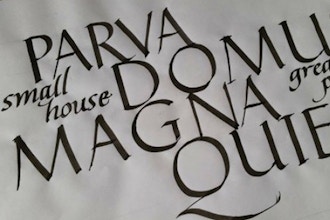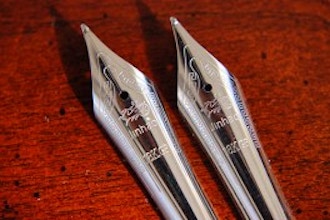Best Calligraphy Classes Near Me
Calligraphy is a visual art form that uses a paintbrush, pen, or other writing instrument to create memorable messages on a variety of mediums. The art of calligraphy can be a cherished hobby, one that results in handmade gifts for loved ones, or it can be transformed into a profitable business developing signs and other marketing materials as part of brand design.
An ancient practice, calligraphy has been around for over 3,000 years and first appeared in English between 1590 and 1610. It then experienced a revival throughout Europe in the 19th century, thanks to British calligrapher Edward Johnston, who started teaching writing, illuminating, and lettering at the Central School of Arts and Crafts in London in 1899.
Coming from the Greek “kallos” which means “beauty” and “graphein” which translates to “to write,” calligraphy uses artistic expression to transform individual letters, whole words, and entire phrases into bespoke masterpieces. From eye-catching signs to intricately-designed wedding invitations, the art of calligraphy can open so many new doors for those artisans dedicated to mastering the craft.
Whether your intention is to begin a new hobby, create intentionally-made gifts for those you love, or start a potentially lucrative side hustle or business, you’ll enjoy the feeling that comes from mastering a new skill and creating something that is all your own.
Why You Should Learn Calligraphy
Forcing practitioners to slow down, focus, and breathe, calligraphy can be an excellent stress-relieving hobby. It can also be cost-effective; all you really need to get started is a pen, nib, paper, and ink. Calligraphy can be a worthwhile hobby for those who love to make homemade gifts. With a little time and minimal supplies, calligraphers can create unique presents to suit any loved one or occasion.
Looking to make new friendships through a mutual interest? Calligraphy as a hobby offers so many outlets for forming a community. From the Society of Scribes & Illuminators in the UK to the Society of Calligraphers in Southern California, there are endless groups and forums just waiting for passionate new calligraphers to join!
For those looking to add to their list of employable skills, calligraphy can lead to the creation of a small business that designs invitations, name cards, and signs for weddings. It can also lead to a side hustle making greeting card designs. From thank-you notes to birthday cards, there is no limit to what can be created. Experts can even launch a small business teaching others calligraphy, broadening their community and encouraging others to follow their passions.
5 Ways to Learn Calligraphy
While learning calligraphy doesn’t require a ton of tools, having an experienced instructor can make the entire process more efficient and enjoyable. Give one of the methods below a try to learn calligraphy:
- Sign up for an in-person class offered in your area. You’ll be paired with an expert instructor and can learn alongside other students. Typically, all supplies are provided by the instructor and a class or learning space will be set up for you.
- Live online classes offer slightly more flexibility. While you’re still guided by a knowledgeable instructor, you also get the added benefit of taking the class from the comfort of your own home. You will, however, be responsible for your supplies and workspace.
- Self-paced or on-demand virtual classes offer students even more flexibility. You can choose when and where you attend class, giving yourself extra time to master a technique when needed.
- Of course, there’s always the option to learn via free video tutorials. While a cost-effective option, you will lack the interaction with a trained expert and, typically, the depth of knowledge available from formal classes.
- Thousands of blogs are dedicated to learning the art of calligraphy, so you could also self-teach through the tips and tricks available on these sites. These blogs often offer extensive archives detailing different scripts, the best pens, nibs, and ink, and what types of paper are best.
With so many options to choose from, it may seem difficult to decide which path is right for you. As you learn more about each option, keep in mind you can explore the history, techniques, tips, and tricks of calligraphy through any of these forms. Formal classes will offer a more in-depth study of the craft and typically help students develop their skills quickly, so either online or in-person courses may be the best fit for you.
In-Person Calligraphy Classes
In-person calligraphy classes are an ideal option for those looking for hands-on experience with an expert. They’re also a great way to gain skills quickly while making friends at the same time. Are you looking to gain new skills so that you can make handcrafted gifts for your loved ones? Or, maybe you’re looking for structured guidance on turning your passion into a career.
Whether you’re starting from scratch or building upon a previously existing talent, an in-person calligraphy class is a great way to explore your passion for the craft.
Modern Calligraphy from the Brooklyn Craft Company in Brooklyn, NYC is designed for beginners, guiding you through the basics of modern calligraphy with a focus on developing your own lettering style. You’ll start with practicing the alphabet, words, and phrases, and end the class with your own finished piece.
Also in New York, Jade Scarlet Art in Manhattan offers a course called Modern Calligraphy: Brush Lettering. This class will teach all the techniques needed for creating the thick and thin lines that are the foundation for creating beautiful brush lettering forms. Also great for beginners, students can practice the basic strokes of lettering, master both upper and lower case, and learn how to connect letters to form words and phrases.
For those located on the sunny coast, Los Angeles also tends to have several classes available. Santa Monica College hosts a course titled Japanese Calligraphy in Multi-Art Forms that teaches the art of Japanese calligraphy with traditional tools. Students will also get to explore the historical context of this beautiful art form through the exploration of Japanese poetry, dance movements, and music. (This class is meant for those with existing knowledge in calligraphy and requires students to complete Introduction to Japanese Calligraphy first.)
Makers Mess in Silver Lake typically offers a beginner-friendly course called Modern Calligraphy. Described as “frustration-free,” this two-hour workshop explores fundamental techniques on pen pressure, lettering, and how to connect letters. Students can expect to use dip pens during this class while they learn all the basics.
Live in the Windy City? The Evanston Art Center offers Contemplative Calligraphy, a class designed for those new to the craft that will explore the tools of calligraphy with an emphasis on using broad-nib pens. Students will learn to render letters in both the Foundational and Italic hands, with additional instruction on topics like spacing, negative space, design elements, and the historical context of hand lettering.
The Art of Calligraphy is offered by the Infinity Foundation in Highland Park. Suitable for all levels, this class invites students to experience the meditative and contemplative nature of the practice. The class will include a variety of examples, as well as a discussion of the historical context of calligraphy while students practice brush lettering with a dip pen. (This course requires students to bring their supplies such as a dip pen holder, size zero nib, ½ inch flat brush, and ink.)
Live in a different area than those listed above? Coursehorse offers a variety of calligraphy classes in locations across the United States. From Chicago to Boston, Atlanta to Denver, available classes span from coast to coast. And, if you happen to reside in an area without any in-person classes, take a look at the virtual offerings to see if they could be the right fit.
Virtual Calligraphy Classes
Having trouble deciding between an online course and one that is in person? There are pros and cons to both. In-person classes offer the obvious benefit of face-to-face time with an instructor, but they also offer other perks like meeting other people with the same interests, having your questions answered in real-time, and (typically) having the space and materials provided for you.
Online calligraphy courses, whether live or on-demand, offer more flexibility for students with difficult schedules or long commutes. Gone are the days of worrying about traffic and the cost of gas. Students simply log into their courses from the comfort of their own homes with access to expert instructors and a virtual community of fellow artisans. Generally, online courses require students to purchase their supplies, and the responsibility of creating or finding an appropriate workspace belongs to the students as well.
Virtual Beginner’s Calligraphy (Part 1 & 2) teaches students the more freeform style of modern calligraphy. A combination of traditional calligraphy and self-expression, students will learn the techniques needed to make the thick and thin lines required with a brush, pen, or even a marker.
Intro to Copperplate Calligraphy is hosted by Design KOUS and is a four-hour course where you will practice the alphabets of casual script calligraphy. Students will gain a better understanding of the correct lines, shapes, and proportions of the letters, as well as develop better control over their calligraphy tools of choice.
Continuing Contemplative Calligraphy is a course available for those who are slightly more experienced with the art of calligraphy. Hosted via Zoom, this class meets once per week for calligraphy practice and guided meditation. The class also includes an interactive Q&A for things like design, layout, and how to develop an artistic eye.
Private Group Calligraphy Classes
Looking to bring a private group calligraphy class to your organization or business? A great team-building exercise, private group classes boast benefits like face-to-face time with an expert instructor, hands-on experience, and the opportunity to cater a class to your group’s specific needs.
You and the group of your choosing can learn to make all the thick and thin lines needed to create beautiful letterforms, with no prior experience necessary! This Virtual Calligraphy Workshop provides two hours of instruction by a professional artist and calligraphy expert. You’ll learn the eight basic strokes of modern brush lettering, tips and tricks for perfecting your lettering practice, and the fundamentals for bouncing and flourishing.
There’s no need to run to the craft shop prior since all supplies are shipped to participants. Before your class, you’ll receive calligraphy pens and markers, stationary for practicing, and worksheets for developing your skills.
The minimum group size for this course is 10, and it’s only an additional $65 for each person thereafter. You can even opt to customize your event, for a $150 customization fee, with things like combining different games, requesting specific questions or a themed game, or adding something to an event with materials included.
With no booking fees and confirmation sent within 24 hours, scheduling a private group class has never been easier. You can even adjust your headcount after booking and can cancel your event for free with a two-week notice.
Interested in learning more before you commit? You can request a 20-minute demo of this event for $100 to ensure it’s the right fit for your organization or business, or you can reach out through the contact form on Coursehorse’s site.
CourseHorse recommends Zoom for virtual group classes, but they can easily accommodate Google Meets, Microsoft Teams, and WebEx. It’s even possible to have courses come to your office or home space, as well.
What Will I Need to Learn Calligraphy?
Worried about what supplies you need to pick up from your local craft store? There are really just four things anyone needs to begin learning calligraphy: paper, a pen, nibs, and ink. While the supplies are minimal, it is important that you pick the ones that will best fit your personal preferences and, eventually, your individual calligraphy style.
Pens
There are two styles of calligraphy pens (also known as nib holders: a straight pen and an oblique pen. Which pen you’ll need is entirely up to your preference. The main difference between the two is that, with straight pens, the nib attaches to the holder in a straight line and, with the oblique, the nib is inserted into a metal flange that is attached to the holder. Essentially, an oblique pen allows you to write at a specific angle while the straight pen does not.
Nibs
A nib is a metal tip that inserts into the pen. There are several different kinds, like cursive italic nibs, flex nibs, oblique nibs, and stub nibs. These pint-sized pieces are interchangeable, meaning you can swap them out depending on the style of your current project.
Paper
While using calligraphy paper isn’t a must, it is advised to practice on either quality printer paper or a paper pad. The key is that the paper be smooth; any sort of texture to the paper could interrupt flowing, effortless brushstrokes.
Ink
Quality ink, however, is very important. You’ll want ink that flows smoothly, like Sumi ink or India ink. It’s best to avoid fountain pen inks as they are very different from your standard calligraphy inks.
Over time, you’ll learn which supplies and tools fit your style best. And, no matter what you choose, you’ll be able to create intentionally-made items that are as unique as you.
Is it Difficult to Learn Calligraphy?
Learning calligraphy can take a lot of practice, especially when you’re starting from the ground up as a beginner. There may be a lot of repetition at the start, with new practitioners filling out worksheets to help refine their lettering skills. Because it takes a lot of practice, it also takes a substantial amount of time and patience; calligraphy isn’t something you’ll learn overnight.
It’s often recommended that new students practice two to three times per week, for a total of about five hours each week. Other tips for beginners include picking one singular lettering style to learn first before you move on to any others. While learning calligraphy requires dedication and determination, it is, ultimately, a skill that anyone can learn if they are devoted to the pursuit.


































